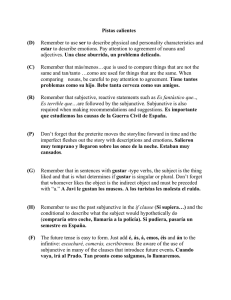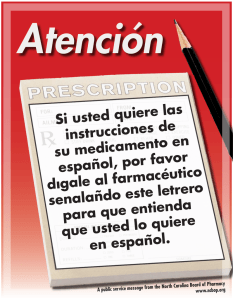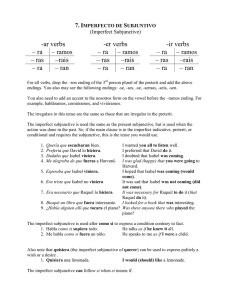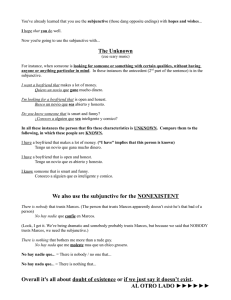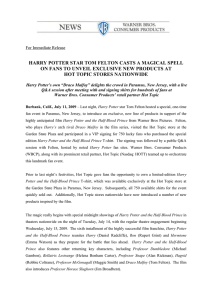Read a sample of this book
Anuncio
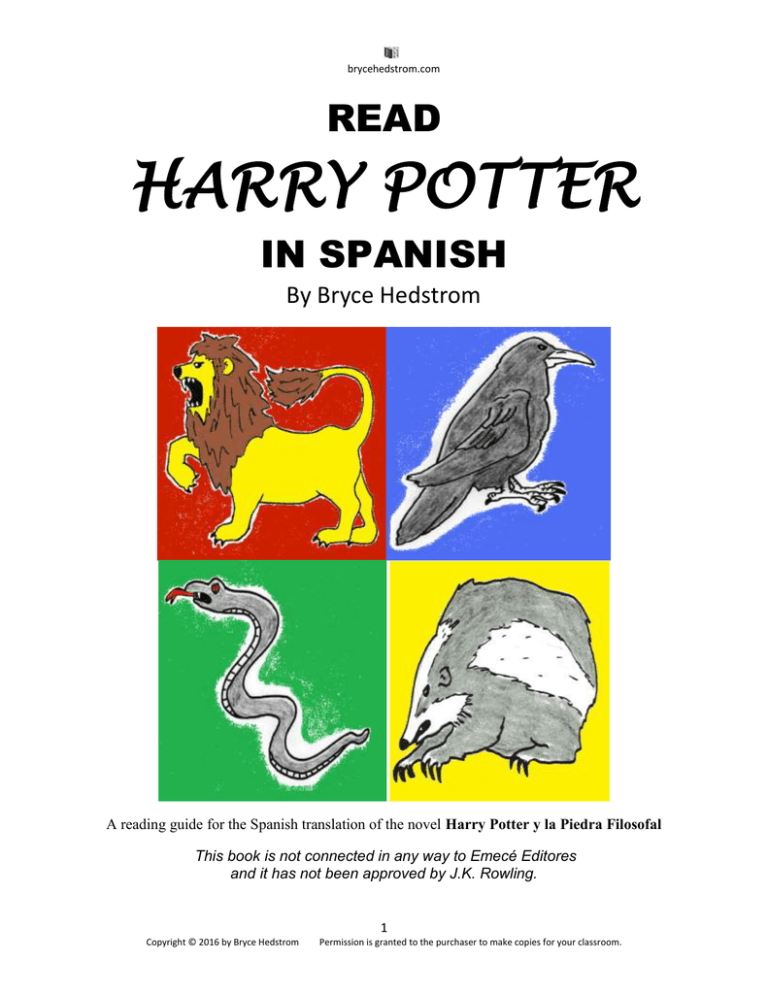
brycehedstrom.com READ HARRY POTTER IN SPANISH By Bryce Hedstrom A reading guide for the Spanish translation of the novel Harry Potter y la Piedra Filosofal This book is not connected in any way to Emecé Editores and it has not been approved by J.K. Rowling. 1 Copyright © 2016 by Bryce Hedstrom Permission is granted to the purchaser to make copies for your classroom. brycehedstrom.com Contents Introduction . . . . . . . . . . . . . . . . . . . . . . . . . . . . . . . . . . . . . . . . . . . . . . . . . . . . . . . . 3 BEFORE READING Essential Vocabulary . . . . . . . . . . . . . . . . . . . . . . . . . . . . . . . . . . . . . . . . . . . . . . . . . 6 Essential Vocabulary Quiz #1 (Spanish to English Quiz) . . . . . . . . . . . . . . . . 8 Essential Vocabulary Quiz #2 (Optional English to Spanish Quiz) . . . . . . . . . 10 Essential Vocabulary Quiz #3 (Optional English to Spanish Quiz) . . . . . . . . . 10 DURING READING Spanish/English Glossary (Important, difficult and/or specialized words in the novel) . . . Page-by-Page Vocabulary Help (Helps students as they read) Chapter 1 . . . . . . . . . . . . . . . . . . . . . . . . . . . . . . . . . . . . . . . . . . . . . . . . . . . Chapter 2 . . . . . . . . . . . . . . . . . . . . . . . . . . . . . . . . . . . . . . . . . . . . . . . . . . . Chapter 3 . . . . . . . . . . . . . . . . . . . . . . . . . . . . . . . . . . . . . . . . . . . . . . . . . . . Chapter 4 . . . . . . . . . . . . . . . . . . . . . . . . . . . . . . . . . . . . . . . . . . . . . . . . . . . Chapter 5 . . . . . . . . . . . . . . . . . . . . . . . . . . . . . . . . . . . . . . . . . . . . . . . . . . . Chapter 6 . . . . . . . . . . . . . . . . . . . . . . . . . . . . . . . . . . . . . . . . . . . . . . . . . . . Chapter 7 . . . . . . . . . . . . . . . . . . . . . . . . . . . . . . . . . . . . . . . . . . . . . . . . . . . Chapter 8 . . . . . . . . . . . . . . . . . . . . . . . . . . . . . . . . . . . . . . . . . . . . . . . . . . . 11 19 20 21 22 23 25 27 29 (The page-by-page vocabulary help ends here because by this time students will have a good handle on most of the specialized vocabulary in the novel) Chapter Quizzes Chapter 1 . . . . . . . . . . . . . . . . . . . . . . . . . . . . . . . . . . . . . . . . . . . . . . . . . . . Chapter 2 . . . . . . . . . . . . . . . . . . . . . . . . . . . . . . . . . . . . . . . . . . . . . . . . . . . Chapter 3 . . . . . . . . . . . . . . . . . . . . . . . . . . . . . . . . . . . . . . . . . . . . . . . . . . . Chapter 4 . . . . . . . . . . . . . . . . . . . . . . . . . . . . . . . . . . . . . . . . . . . . . . . . . . . Chapter 5 . . . . . . . . . . . . . . . . . . . . . . . . . . . . . . . . . . . . . . . . . . . . . . . . . . . Chapter 6 . . . . . . . . . . . . . . . . . . . . . . . . . . . . . . . . . . . . . . . . . . . . . . . . . . . Chapter 7 . . . . . . . . . . . . . . . . . . . . . . . . . . . . . . . . . . . . . . . . . . . . . . . . . . . Chapter 8 . . . . . . . . . . . . . . . . . . . . . . . . . . . . . . . . . . . . . . . . . . . . . . . . . . . Chapter 9 . . . . . . . . . . . . . . . . . . . . . . . . . . . . . . . . . . . . . . . . . . . . . . . . . . . 31 32 33 34 35 36 37 38 39 (The chapter quizzes end here because students will finish reading the book on their own from this point on.) ACTIVITIES Las Casas de Hogwarts (Accompanies chapter 7) . . . . . . . . . . . . . . . . . . . . . . . . . . . 40 The Sorting Hat (Fun way to put students in teams for activities and games) . . . . . . . 41 Using the Subjunctive (Notes and explanation for grammar part of quizzes). . . . . . . 42 AFTER READING Subjunctives and Harry Potter . . . . . . . . . . . . . . . . . . . . . . . . . . . . . . . . . . . . . . . . Jeopardy Game (Review) . . . . . . . . . . . . . . . . . . . . . . . . . . . . . . . . . . . . . . . . . . . . . . Final Project Questions (Use these in class discussions while reading) . . . . . . . . . . . Example of Student Final Project . . . . . . . . . . . . . . . . . . . . . . . . . . . . . . . . . . . . . . 44 46 48 50 This guide is not connected in any way to Emecé Editores and has not been approved by J.K. Rowling. 2 Copyright © 2016 by Bryce Hedstrom Permission is granted to the purchaser to make copies for your classroom. brycehedstrom.com INTRODUCTION This guide is based on a translation of the novel Harry Potter y la Piedra Filosofal in Castillian Spanish by Emecé Editores in Barcelona, Spain, originally published in 1999. There are editions of the book available in Latin American Spanish, but the Castillian edition was chosen to help accustom students to the vosotros form that is used throughout. If your novel is is the Latin American Spanish edition some of the words will be slightly different, but this guide will still be useful. HARRY IS NOT JUST FOR KIDS Even though some students might consider the Harry Potter series to be old stuff, I like using it occasionally with upper level students. Reading this novel can be a nice break from the heavier culture and literature they are expected to master in an upper level course. Students are familiar with the novel and it feels like a break to them. Reading the book takes them back to the joyful free reading of their early days in school. The real value in reading a book like this is the constantly recycling high frequency vocabulary in an engaging format. But don’t allow students to think that Harry Potter is just for kids. According to a CNN news story, J.K. Rowling’s books are being used more and more in college literature courses. Universities such as Yale, Georgetown, Pepperdine, Stanford, Swarthmore and Kansas State all offer courses on Harry Potter and more are added at other campuses every year. These are courses that focus on the literary, historical and theological content in the books and compare them to the works of J.R.R. Tolkien, C.S. Lewis, and other British literature. YOUR STUDENTS ARE HARRY POTTER When they re-read the first Harry Potter novel in Spanish, students often see a lot more in it than they did when they read it in English were younger. It can almost be therapeutic for them. Some of my students remark how they consciously relate to Harry now—all too often they also feel trapped in a world of dull individuals that do not appreciate their unique gifts. They see and feel wonder all around them that others do not perceive. Discussing the novel in the target language in class often helps them to relflect on and work through some of those feelings. Time and again, situations in the book remind them of events in their own lives and they want to share. Encouraging lively classroom discussions with this book is no problem. Once you get the ball rolling, the problem becomes cutting off the conversation so we can get back to reading. READING THE NOVEL I tend to teach Harry Potter much in the same way as I would any novel—we go through the first half of the novel together slowly and carefully (the deluxe tour), and the second half of the book, students read on their own (the budget tour). In the first few chapters, vocabulary that students need to know is gleaned and we work with it with classical TPR, Personalized Questions and Answers (PQA) and personalized mini-stories to help prepare students to read the novel. I like to read this book aloud to them for at least the first eight or nine chapters because so much of the vocabulary is unreal—J.K. Rowling invented a lot of words for her novels and students may not always recognize the Spanish interepreation of her terms. Quality Spanish recordings of the novel are also available at most libraries and playing these can be a real voice saver. My favorite technique is to discuss and summarize what we have read as we go along. Reading the novel together in class and discussing as we go is the best way to handle this because the material is so familiar and available. Some students will be tempted to read the book in English or just watch the movie if assigned to read at home on their own. When we read together in class, that pressure is dissipated and students can focus on the joy of reading. PACING Setting aside a three week window to read the entire book has worked well for me. As with most novels, the first part is the deluxe tour of the book—they get my help. I point out vocabulary and connections and spark discussions. The last half of the book is the economy tour—they read on their own. With a good start and accountability along the way, most students can finish the novel. I suggest that most reading be done in class—the books and movies are so widely available that the temptaition to read in English will be too much for some students. If they want to read in English on their own at home, that is fine. Chapter length is quite variable in the novel. Long Chapters (1, 5, 6, and 13) may require two or even three days to read and discuss in class, while Short Chapters (2, 3, 4, 7, 9 and 10) can be read aloud and discussed in one 3 Copyright © 2016 by Bryce Hedstrom Permission is granted to the purchaser to make copies for your classroom. brycehedstrom.com class period. The Very Short Chapters (8, 11, and 12) may be read and discussed in less than one class period. The rate at which students read will speed up the further students get into the novel. We can learn the new vocabulary, play with it with PQA and read part or all of a chapter every other day. A typical schedule for the novel would be: • Day 1: Vocabulario Esencial. Ask which students have read the novel in English. Pass out copies of the Essential Vocabulary. Discuss cognates and which words most students already know. Teach the rest of the vocabulary in red print with classical TPR and some questions and answers, both personalized (PQA) and about the novel. • Days 2 & 3: Vocabulario Esencial Quiz #1 (page 8); Check out books to students along with copies of the dictionary (p. 10-17) and page-by-page vocabulary help (p. 19-29). Begin reading the novel aloud in the T.L. as students follow along, stopping frequently to check for understanding and to discuss interesting passages. When students are reading slowly and in another language, meaning will jump out at them—they will see things that they have never noticed before. If they are gently guided, students will quickly discover how much they indetify with Harry Potter. Review or introduce the SIPS + Would formula (see below) and look for it in the text as you read. • Day 4: Chapter 1 Quiz (page 31); Begin reading chapter 2 aloud in the T.L. and discuss. • Day 5: Continue reading chapter 2. Review or introduce the acronym PMS En CA (see below). • Day 6: Chapter 2 Quiz (page 32). Begin reading chapter 3. • Days 7-13: Continue this pattern of reading in class, gradually weaning students of off listening to the teacher and reading alone. A good technique here, that will also save you voice is to get a recording of the exact same version of the book and play it aloud as students read along. Slowing down the recording to 85% or so can help until students have become accustomed to the narrator’s voice. Continue with the chapter quizzes (pages 31-39) to hold students accountable. • Day 14: Jeopardy Game. This is a fun way to review the novel in the T.L. Pass out copies of the final rpojuect and discuss. • Day 15: Final Project. Students write in class. DICTIONARY AND PAGE-BY-PAGE VOCABULARY HELP These recources have been delveloped through years of teaching the novel in Spanish IV and AP classes, and by answering questions of students in Spanish III that have chosen to read the book for free reading. The Essential Vocabulary on the next page has proven invaluable in getting students to undertand the novel quickly. CHAPTER QUIZZES The chapter quizzes are designed to check student comprehension of key vocabulary and the content in each chapter. The quiz vocabulary items can be good ones to pre-teach with classical TPR and PQA. There are chapter quizzes through chapter nine. By that time students will have become much more confident and comfortable with the esoteric vocabulary found in the novel and they will be expected to finish reading on their own. At the end of each quix there is also an optional grammatical component on the subjunctive. GRAMMAR IN THE CHAPTER QUIZZES As we go through the book, I take every opportunity to point out and use the many instances of the subjunctive in the text. The book is crawling with the subjunctive—examples of how characters feel and what they want are everywhere; students will read them on virtually every page. Those discussions are reflected in the last section of each of the nine chapter quizzes. A simple explanation on using this technique of teaching/reviewing the subjunctive is included on page 42. If you want your students to jump right in and focus on meaning, you may feel that teaching the acronym and formulas may be unnecessary. I can understand that. I have had students in levels II and III read the novel with 4 Copyright © 2016 by Bryce Hedstrom Permission is granted to the purchaser to make copies for your classroom. brycehedstrom.com minimal help with the past subjunctives. Once they were able to recognize fuera, tuviera, estuviera, pudiera, hubiera and quisiera they were able t oread on their own. Keep in mind that according to research by Stephen Krashen and others, the only dependable way that students have been measured to master the subjunctive is through pleasure reading—the very type of reading we are promoting with this novel! Explicit teaching does not create this mastery, but teaching it can ease the nervousness of teachers and students around using the subjunctive, so it elements of explicit subjunctive teaching are included in the chapter quizzes and in the exercise at the end of this guide (page 44). • Chapter 1 Quiz The acronym SIPS + would is used in the grammar portion of the chapter one test. SIPS + would is the formula for si past subjunctive, would… as in: Si yo tuviera un millón de dólares, lo daría todo al professor de español. Si no lo hubiera hecho así, aquella mañana le habría costado concentrarse en los taladros. • Chapter Quizzes 2 & 3 The mnemonic device PMS en CA is used to help remind students when to use the subjunctive with these expression that require it almost 100% of the time. The letters stand for: para que…, a menos de que…, sin que…, en caso de que…, con tal de que..., antes de que… • Chapter Quizzes 4 & 5 The mnemonic device THE MCD is used to help remind students to use the subjunctive when referring to the future with certain words. The letters stand for: tan pronto como…, hasta que…, en cuanto que…, mientras…., cuando…, después de que… • Chapter Quizzes 6-9 The idea of using the subjunctive mood with impersonal expressions is reviewed here. THE SORTING HAT In the middle of chapter seven the students in my classroom get divided into the four houses of Hogwarts, just as the characters in the story are. Each house gets to devise a logo and and motto based on the descriptions in the book. From that time on they work with the members of their house to compete in vocabulary games and in the final Jeopardy Review Game. They can also read with their houses when they get to the last half of the book (from chapter 10 on) and we stop reading together as a class. JEOPARDY GAME This is a game to review the content and vocabulary in the book. Write the categories and point values on the board and let the previously sorted “houses” play off against one another before the final project. FINAL PROJECT Students may select from several big themes in the book to write about to show they have read and understood the book. Be sure to review these questions as you go thorugh the novel with your class to help prepare your students to think about these ideas and hear others’ thoughts about them as you all talk in class. Acknowledgements: Thank you to Carmen Andrews Sánchez of Las Vegas, Nevada for her ideas on the first three chapter quizzes and permission to use them. Thanks to Nelly Hughes for her valuable suggestions and editing. All remaing errors and bad ideas herein are mine alone. 5 Copyright © 2016 by Bryce Hedstrom Permission is granted to the purchaser to make copies for your classroom. brycehedstrom.com HARRY POTTER Y LA PIEDRA FILOSOFAL VOCABULARIO ESENCIAL All of the words on this list are important to understand the story, but the bold words are essential to know. You will be tested on the words in bold red print (Spanish to English) before we start reading. PALABRAS E IDEAS CLAVES KEY IDEAS AND WORDS (Estas palabras no aparecen mucho en el texto, pero el tema del libro tiene que ver con ellas) prejuicio estereotipo orgulloso normal prejudice stereotype proud normal COSAS MÁGICAS MAGIC THINGS la magia magic (noun) mágico magic (adjective), magical mago wizard bruja witch varita wand hechizo encantamiento encanto maldición maleficio embrujar hechizar brujería lechuza lechucería búho ulular ululación mantener(se) alejado sacrificio sacrificar(se) la amistad to keep away from sacrifice to sacrifice (oneself) friendship escoba fantasma capa túnica broom ghost cape tunic a magic spell, charm enchantment, spell charm, spell curse curse, evil spell to put a spell on, bewitch to bewitch, to cast a spell on witchcraft owl owlry, owl roost, owl cages owl to hoot, hooting (gerund—a verb used as a noun) hooting (noun) LUGARES MENCIONADOS FRECUENTEMENTE EN LA NOVELA bosque forest torre tower castillo castle escaleras stairs, stairway despacho office vestíbulo entryway, vestibule mazmorra dungeon comedor dining hall GESTOS COMUNES POR TODA LA NOVELA encogerse de hombros se encogió de hombros encogiéndose de hombros encogiéndose de hombros to shrug one's shoulders shrugged his shoulders shrugging his shoulders shrugging his shoulders entrecejo fruncir el entrecejo frunció el entrecejo eyebrows to frown frowned 6 Copyright © 2016 by Bryce Hedstrom Permission is granted to the purchaser to make copies for your classroom. brycehedstrom.com frunciendo un poco el entrecejo con los entrecejos fruncidos con el entrecejo fruncido frotándose la frente alzó las cejas mirándolo ceñudo frowning a little frowning frowning frowning raised his eyebrows frowning ponerse de puntillas negar con la cabeza le puso la cara mala to stand on tiptoe to shake one's head no got a mad look on his/her face MÁS VOCABULARIO ÚTIL QUE SE ENCUENTRA EN LA NOVELA amenazar to threaten amenaza a threat amenazador/a threatening (adjective) castigar el castigo to punish punishment cicatriz chispas scar, cicatrix sparks veneno envenar envenado venenoso poison, venom to poison poisoned poisonous lúgubre pergamino mournful, lugubrious, sad parchment (old fashioned writing material made of sheep skin) silbar silbante silbato silbido to whistle whistling the whistle the whistle ténebre tenebroso dark dark, shadowy (adjective) siniestro carcajada darse cuenta de que ni siquiera susurrar súbitamente sinister (also left-handed) a derisive laugh meant to mock or put down another to realize not even to whisper suddenly 7 Copyright © 2016 by Bryce Hedstrom Permission is granted to the purchaser to make copies for your classroom. brycehedstrom.com HARRY POTTER Y LA PIEDRA FILOSOFAL VOCABULARIO ESENCIAL QUIZ #1 1. mago _________________________ 2. bruja _________________________ 3. varita _________________________ 4. escoba _________________________ 5. hechizo _________________________ 6. lechuza _________________________ 7. bosque _________________________ 8. castillo _________________________ 9. despacho _________________________ 10. mazmorra _________________________ 11. torre _________________________ 12. escaleras _________________________ 13. comedor _________________________ 14. se encogió de hombros _________________________ 15. frunció el entrecejo _________________________ 16. amenaza _________________________ 17. castigar _________________________ 18. el castigo _________________________ 19. cicatriz _________________________ 20. chispas _________________________ 21. pergamino _________________________ 22. silbar _________________________ 23. tenebroso _________________________ 24. carcajada _________________________ 25. darse cuenta de que _________________________ 26. ni siquiera _________________________ 27. súbitamente _________________________ 8 Copyright © 2016 by Bryce Hedstrom Permission is granted to the purchaser to make copies for your classroom.
